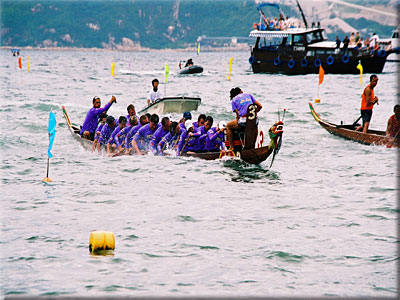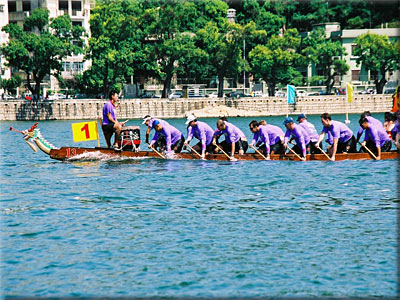Midnight Crossing
Paddling the waters of Hong Kong
By Antonio Graceffo
An unemployed travel writer and former merchant seaman, I was bumming along the coast near Hong Kong’s Deep Water Bay, when I stumbled onto a sign which read “Boat trip around the world, only $100 HK.” Having nothing to keep my interest on shore, and very little money in my pocket, I signed on. Next thing I knew, I was chained to an ore. Behind me, a large scary fat man, dressed only in a loincloth, pounded a drum, timing the rowers. Missing a beat was punished with a sharp whip-crack, between the shoulder-blades. Filled with fear and trepidation, I watched the bright lights of my beloved city disappear in the boat’s rearview mirror. After a year of unimaginable privation and torture, we returned to Deep Water Bay.
As the shackles were being removed from my wrist, I turned to one of the other rowers and said, “I can’t believe they charged a hundred dollars, but then made us do all the work.”
“I know.” He said, shaking his head. “Last year it was only eighty dollars.”
I may have exaggerated a bit. And I don’t want Humanitarians International to go
raid the boathouse, looking to free the galley slaves imprisoned there. But, if
you are looking for excitement and exercise with a nautical flavor, you could
visit the Hong Kong Island Paddlers, and catch onto the sport of outrigger canoe
racing, which is sweeping the globe.
An outrigger is a long, slim canoe, manned by one, two, or eight people. It differs from a traditional canoe in that it has a stabilizing arm attached to a pontoon, which runs alongside.
The sport is generally associated with the US state of Hawaii. Who could ever forget the opening credits of the TV show, “Hawaii Five-O,” with those huge Hawaiian men paddling the outrigger in the surf? Interestingly, however, historians believe that the sport originated in Indonesia, and was exported by way of migration, to Samoa and other parts of Polynesia. Whatever the historical origins, modern outrigger racing is tied to Hawaii. Today, in addition to the teams found in USA and Hawaii, there are teams and competitions in such diverse locations Australia, Indonesia, New Zealand, Philippines, Taiwan, and Mainland China. But no matter where you find outriggers, you will find Hawaiian vestiges of the Hawaiian language.
For an outrigger enthusiast, the boat’s spars is called an iako. The floatation device is the ama, and the hull is the ka'ale. The names used for the canoe itself include: Wa'a- Hawaii, Va'a- Tahiti, Waka Ama- New Zealand.
The commands used on many of the boats can also be called in Hawaiian. Go forward is Imua, pull is huki, paddle is hoe. A canoe paddler is a hoe wa'a.. My friend Adam Giles brought me to Hong Kong Island Paddlers, where I was well-received by a friendly and diverse group of Hong Kongers, male and female, both Gwei Lo and Chinese, who derive pleasure from straining their muscles, paddling around the Bay. Since most people living in the city are notoriously busy with their jobs, paddler training sessions are held late in the evening to give everyone time to eat a snack before beginning their two hour workout regimen.
“Tell the new guy not to huli.” Someone advised.
“Don’t what?” I asked Adam.
“Don’t huli. That means don’t capsize the boat.” Explained Adam. “If you do, the whole team will fall in the water, and everyone will hate you.”
Some paddlers worked for big corporations, others were teachers or business owners. So they were all different. But the one thing they had in common was that they were in great shape. All of the men had bigger biceps than me. And I was certain that even the women could have beat me in a fair fight. It wasn’t hard to believe that they would drown me at sea for turning over the boat. I threw open my notebook and quickly scribbled, “Note to self. Don’t turn over the boat.” With the safety briefing over, Adam began teaching me the mechanics of outrigging. “First you will need to learn how to huki.” He began, taking up a paddle. “But you said not to huki or everyone would hate me.” I pointed out.
“No, huki is rowing . Huli is capsizing.” Explained Adam.
I knew that this sport was going to be hard. “So, you want me to huki, not huli?” I asked, clarifying.
Resuming the lesson, Adam showed me that handling a paddle is a baletic art form, requiring proper body position and mechanics.
Step one, you have to brace your self by planting your feet firmly on the floor of the canoe. Step two: Use your entire body, not jut your biceps. You should also employ your back, stomach and shoulders. When you reach and stroke, you should rotate from the waste, not jut from the shoulders. Your top hand must be strong, riving the paddle forward and down. The stroke should be smooth, with pause at the end. The paddle should enter and leave the water with very little splash.
It was a lot to remember. What if I paddled wrong and we hoolied? I wondered.
Would we become shipwrecked on some deserted island, and have to resort to
cannibalism to survive? I hoped not, most of the paddlers were too muscular and
you would be chewing for hours. Besides, if you ate one of the Chinese teammates
you wold just be hungry an hour later.
After explaining my individual paddling responsibilities to me, Adam explained how the team actually worked in a boat. Most of the time, the odd number paddlers would have their paddles on one se, and the even numbered would have theirs on the other. As a paddler, it was very important to stroke at the same time as the others, keeping on eye, not on the man in front of you, but instead on the man, two positions in front of you, who was paddling on your same side. If you find yourself out of sync, it is important not try and catch up. Because, if you paddle out of sync, you will impede the forward progress of the boat. Instead, you should just wait it out, miss one stroke, and join in on the next one. Each team member had his own special job, depending upon where he was sitting in the boat. The paddler in position 1 is responsible for pace. Position 1 also keeps an eye on the wind and water, looking for opportunities to gain distance and speed by surfing the boat. Position 2 was responsible for timing of the even numbered paddles, on the opposite side of the boat. They use signals such as “reach” meaning that paddlers should increase the length of their stroke. Position 3 might call out the “huts” or strokes. Positions 4 and 5 are powerful drivers. Position 6, the steersman, is responsible for safety; as well as steering and navigation. The steersman also acts as a coach, calling out encouragement to the paddlers, keeping them motivated. All team members are responsible for passing messages up and down the boat.
Paddling is one of the most teamwork-intensive sports I had ever participated in, and could easily see how it could be used as a tool in teambuilding training courses in corporations and financial firms.
For individuals, with no experience, it is much easier to take up outrigging than it is to start kayaking or some individual sport. Since outriggers have the advantage of practicing with a team, as a novice you can get in a boat your first night, and start paddling. With a good steersman and some patient teammates, you can learn as you go.
In addition to being an incredible exercise an excellent social interaction, the paddling team can be a good venue for cultural exchange, as they also train in traditional dragon boat racing, Many of the teams are composed entirely of Hong Kong Chinese villagers who make their living as fishermen. According to club members, some of the teams from mainland China have large numbers of women, who can pull as well, or better, than the average gwi lo in Hong Kong.
Once we started training, we did various types of racing exercises such as short sprints and long distance runs across the bay. It was exhausting, and as a beginner, I often found myself falling behind simply because of fatigue. But, when the boat was functioning properly, with everyone pulling at the same time, you had an incredible feeling of speed and power I had never experienced in another sport. A tam of powerful rowers can actually lift the boat out of the water. And if you aren’t careful, yes, you could huli.
One of the coolest differences between an outrigger and traditional canoe is that an outrigger can surf. A good team knows how to read the water, hitting the waves just right, so that the boat actually hydroplanes, skipping across the surface, using no energy at all. According to club members, this is the special strength of the Hawaiian teams who still tend to dominate international competitions.
During our racing sprints I was paddling with such intensity, that the problems of the world melted away from me. The only think I thought about was the paddle of the man two position in front of me. I lived and died by the rise and fall of that paddle. The only force I was aware of, apart from the paddles, was the voice of the steersman, cheering us on.
My heart pumped. My shoulders raised and lower. My waist twisted. I pulled, and chilling seawater sprayed on my face, reviving me. Suddenly, the command came to stop. We had crossed the finish line. I didn’t care if we had won or lost. My body felt completely alive. Every muscle had been worked, and my lungs had been cleared of all that horrible smog I had picked up in the city. The feeling of camaraderie in the boat was intense. There is a closeness, which grows between strangers, after a shared ordeal.
Speeding across the Bay, in the dark, I was reminded of Canadian bootlegger, and world-class rower, Ned Hanlan, who transported crates of illegal whisky, in his row boat, outrunning US police officers in powerboats. I kept expecting to be boarded and searched. If nothing else, I thought that the immigration officials would want to see if we were transporting illegal refugees.
But, silly criminal references aside, training in Deep Water Bay, at night, is an experience everyone should have at least once in their life. There is a solitude on the water, unimaginable in the over-populated jungle of skyscrapers in the city, only a few miles away. With time the great experiences of your life will gain. The same is true of places. With distance, the skyscrapers and electric lights of Hong Kong became the most beautiful site imaginable. Looking back at the shore, I could see the rolling mountainsides covered in mansions and thousands of lights, dotting the night sky, like stars.
Copyright © Antonio Graceffo